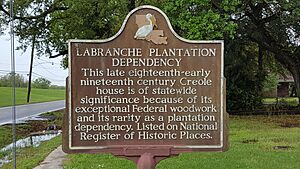LaBranche Plantation Dependency facts for kids
Quick facts for kids |
|
|
LaBranche Plantation Dependency
|
|

LaBranche Plantation Dependency
|
|
| Location | River Rd. (LA 48), St. Rose, Louisiana |
|---|---|
| Built | 1792 |
| NRHP reference No. | 84000145 |
| Added to NRHP | October 18, 1984 |
The LaBranche Plantation Dependency House is a special old building in St. Rose, Louisiana. It's located in St. Charles Parish, Louisiana. The original LaBranche Plantation was once very grand. It was one of the biggest on the German Coast until it was destroyed. This happened during the American Civil War. All that was left was this smaller building. It's known as a dependency house or a garconnière. This French word means "bachelor quarters."
A Look Back in Time
A family from Germany, the Zweigs, bought the land. They built the main plantation house and other buildings in 1792. Sadly, the big house was destroyed during the American Civil War. Today, there isn't much left to show where the grand mansion stood. But you can still see a beautiful path. It's lined with old oak trees.
The dependency house was built in the late 1700s. It was typically used for young bachelors. It's very important because of its unique "Federal woodwork." This is a special style of decoration. It's also rare because it's one of the few plantation dependency buildings that still exists. In 1902, Olidé and Marie Perilloux Cambre bought the house and land.
What Remains Today
The place where the main manor house once stood is private land. You cannot visit it. The Dependency House itself is owned by the Lentini family. They bought and restored it in 1983. On October 18, 1984, it was added to the National Register of Historic Places. This is because of its beautiful woodwork and its rarity.
The property also has a preserved slave quarters building. This building has been restored. It helps us understand the living conditions of enslaved families. Preserved slave quarters are rare in this area. Many plantations were bought by oil refineries or factories. Any remaining slave housing was usually torn down.
You can also find something unique on the site. It's the bathtub that belonged to Zachary Taylor. He was the 12th President of the United States from 1849 to 1850.




